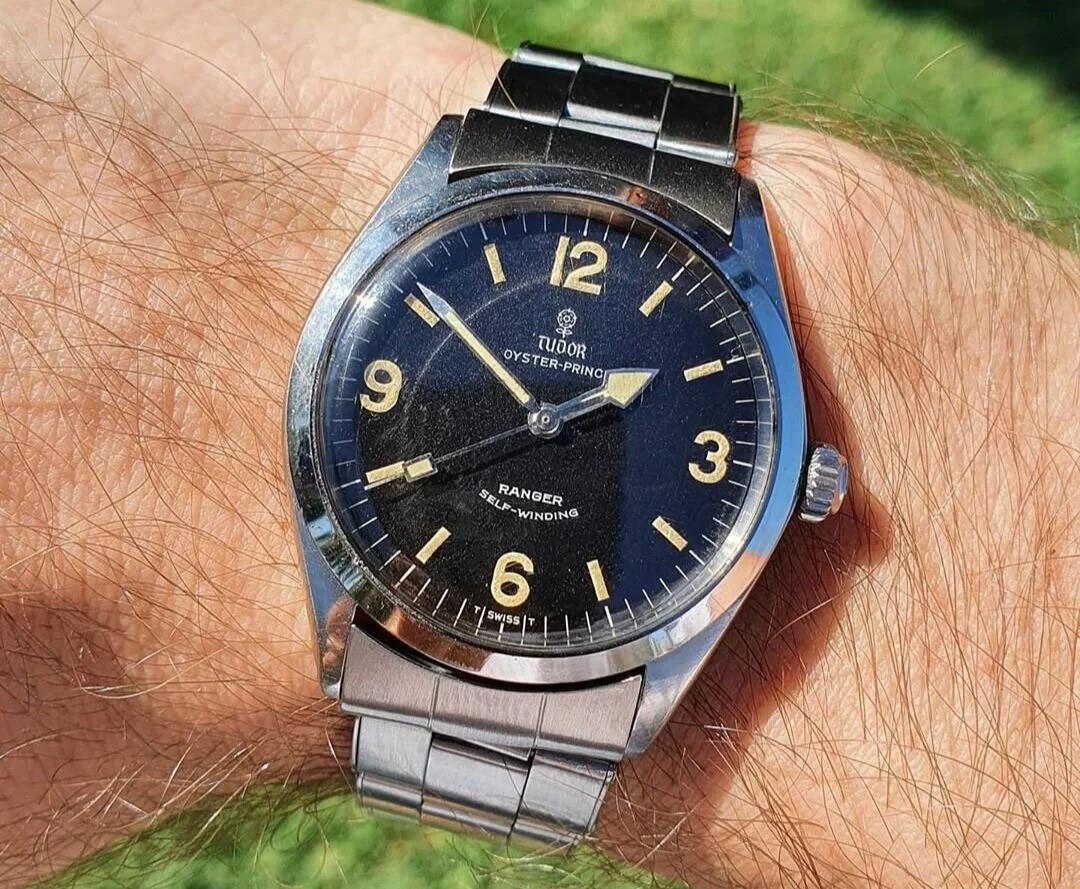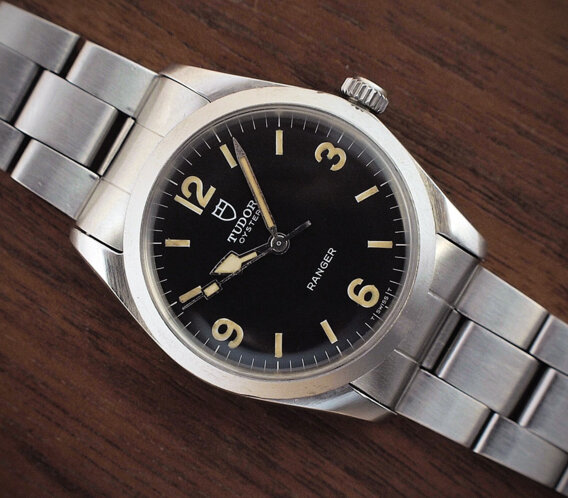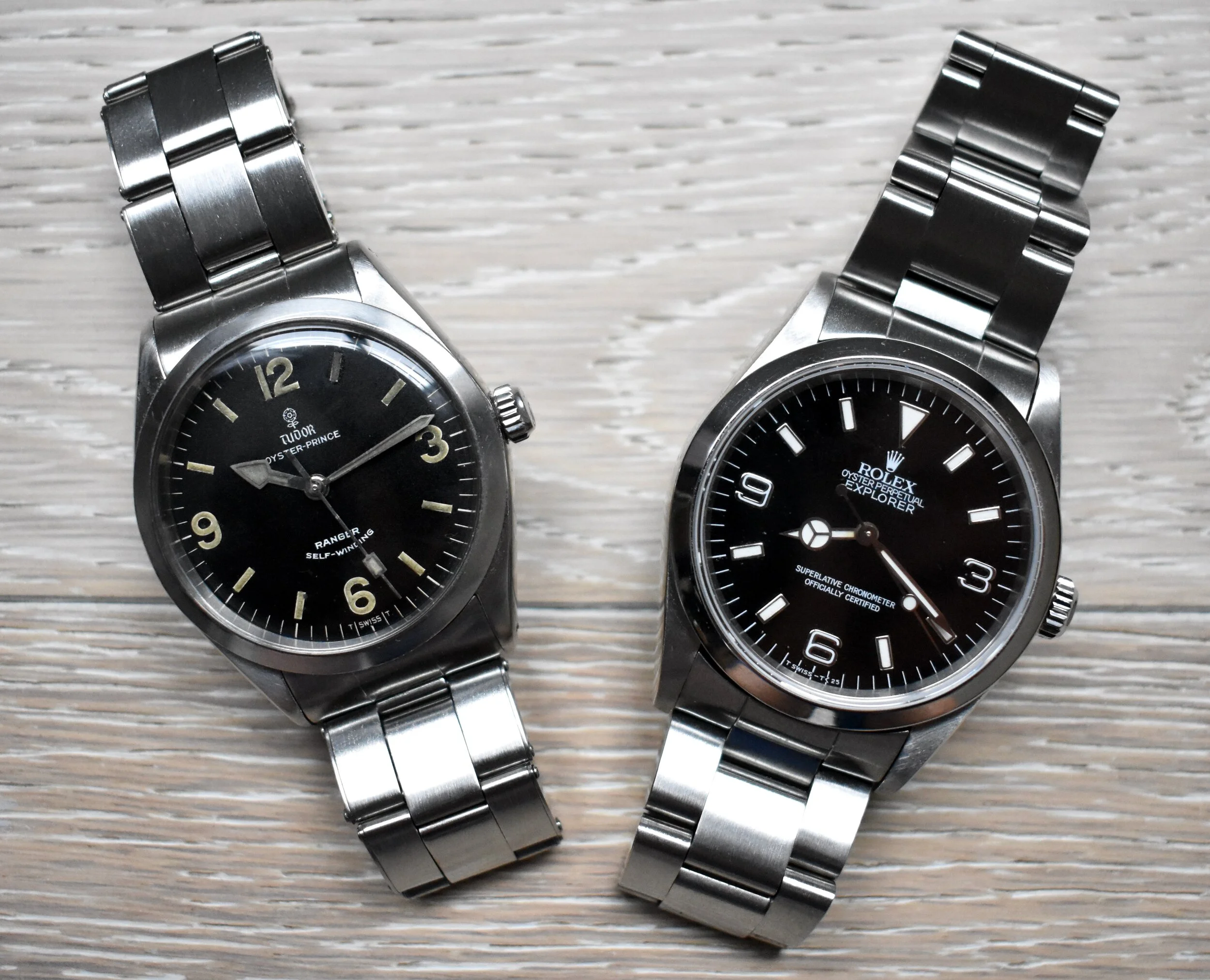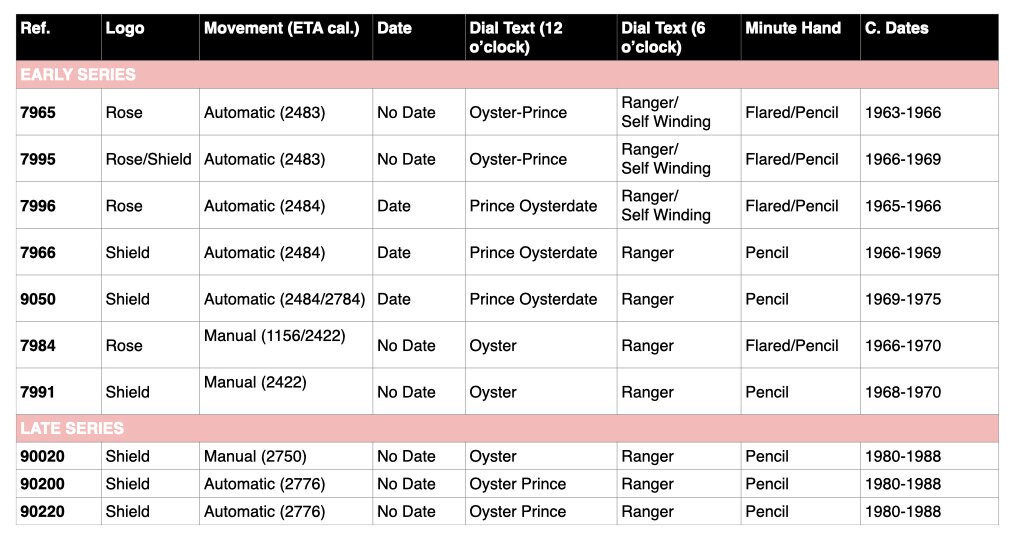Tudor Ranger models are: 7992, 7984, 7934, 7964, 7990, 7963, 7966/0, 90330, 90020 and 90220. The Ranger can be divided neatly into two “series”, i.e. the “Early Series” and “Late Series”. The Early Series are those Rangers produced through the 1960s and 1970s that share references with the standard Tudor Oysters and Oyster-Princes of the day, corresponding with references 79xx. The Late Series are the 90000 series of Rangers produced during the 1980-1988.
There is nothing particularly special about the Tudor Ranger. It didn’t accompany adventurers to Mount Everest or Antarctica. Even the name, “Ranger”, evokes less audacious feats than Explorer or Submariner — perhaps conjuring more benign images with words like “Power”, “National Park”, or “Walker, Texas” preceding it.
But, the Tudor Ranger — this unassuming, 34mm watch — has long beguiled collectors new and old. It’s even been called “the most faked vintage watch” around, prompting some to give blanket advice not to even attempt to acquire one for risk of ending up with a fake or a frankenwatch that’s been put together. This has always struck me as unfortunate: the internet has unlocked an entire world of watch collecting and information sharing, but for some reason the Tudor Ranger has remained an enigma, devoid of a comprehensive cataloging.
Even with the surge in popularity of the Rolex Explorer reference 1016, and smaller vintage watches generally, there has not been a compilation of the Tudor Ranger and its various iterations. In broad strokes, it’s similar to the Explorer: black dial, 3-6-9 Arabic numerals (“Explorer dial”), stainless steel case, and produced from the 1960s through the 1980s. But the vintage Ranger measures 2mm smaller than the vintage Explorer. Additionally, you’ll find date and no-date iterations of the Ranger. And while the Explorer had its own, single reference throughout this time period, the Ranger can be found in a number of references, all with slightly varying traits.
What is the Tudor Ranger?
In between the lugs on either side of the case, Rolex and Tudor typically engrave the reference number and the serial number of the watch, giving collectors much of the information they need regarding a watch’s model and production date. Herein lies the beginning of the difficulty: the Tudor Ranger isn’t a specific reference as much as it is a configuration of a Tudor Oyster, put together in Geneva. Throughout the 1960s and 1970s, Tudor Rangers were produced in the same case reference numbers as typical Tudor Oysters, Oyster Princes and Oysterdates.
That is to say, the Tudor Ranger is a 34mm Tudor Oyster with a matte black dial featuring Arabic numerals at 3-6-9-12, a distinctive shovel hour hand, ETA caliber, and Rolex-signed crown, offered on an Oyster-type bracelet.
Thus, to understand the Ranger, it is also important to understand the Tudor Oyster line to discern whether a particular Ranger is correct and original. Not until the 1980s, with the introduction of the 90000 series, did the Tudor Ranger receive its own case reference number.
A WORD ON RED RANGERS

Much of the caution in relation to Rangers comes from the torrent of “Red Rangers” you’ll find with a simple eBay search. Despite a forum legend that someone, somewhere may have had a legitimate Red Ranger and had it serviced by a Rolex Service Center (this forum post may be the source of such claims), all Red Rangers are generally regarded as fake dials.
Tudor Ranger: Origins

Early advertisement for the Tudor Oyster Prince
Ranger examples should correspond to the references of a typical Tudor Oyster or Oyster Prince model, with matching signature and text on the dial. Common early Tudor Oyster case references that can feature Ranger configurations include:
Reference 7965, 7995: Oyster Prince (automatic, time only)
Reference 7966, 7996: Prince Oysterdate (automatic, date complication)
Reference 7984, 7991: Oyster (manual, time only)
Reference 9050: Prince Oysterdate (automatic, date complication)
For instance, a Tudor Oyster-Prince reference 7995 is an automatic, time-only model, whether or not it is a Ranger. Another common Ranger reference, 9050, is a Prince Oysterdate model. You should never find, for example, a date complication in a 7995 case, or a time-only caliber in a 9050. This rule applies for Ranger and non-Ranger examples alike.

A standard Tudor Oyster Prince reference 7995. Note it features the same Oyster-Prince and Self-Winding text as the Ranger of the same reference. | Source: Analog/Shift
Unlike with the Submariner or the brand’s chronographs, the Tudor website makes scant mention of the history of the Tudor Ranger, offering just this:
The Tudor Oyster Prince Ranger model was introduced in the 1960s and was first listed in the catalogue in 1969. It remained in the catalogue until 1988. The model presented here (reference 7995/0) [Ed. note: see images below] dates from 1967 and has a 34 mm waterproof steel case. Its matte black dial with the rose logo is punctuated with luminous rectangular hour markers and luminous Arabic numerals at 3, 6, 9 and 12 o’clock. Its characteristically shaped hands also feature luminous material. Its self-winding movement is the ETA calibre 2483 with the signature “Tudor Auto-Prince” on the rotor. The steel Oyster-type bracelet (reference 7835) has folding links and a Rolex signed clasp.
Tudor is non-committal as to the exact year when the Ranger was introduced, but we first see it appear in catalogues in 1969. It also seems likely it wouldn’t have been introduced before the Rolex Explorer came into its own with the release of the Reference 1016 in the early 1960s.

Vintage Ranger Ref. 7995/0, featuring an automatic ETA caliber 2483 | Source: Tudor Watch

Tudor Ranger: Early Series
In Isnardi’s Tudor Anthology, the author dismisses all rose Rangers as fake. This is emphatically not the case, as dozens of verifiably correct and original rose Rangers have been found (and, as discussed above, Tudor itself has verified a rose Ranger as the inspiration for its modern Heritage Ranger). However, because the Ranger did not begin to appear in Tudor catalogues until 1969, by which time the brand had begun to transition from its rose logo to the shield logo, there has been confusion.
Like with other Tudor models, the move from the rose to the shield logo can be observed in examples dating to a few years before Tudor “officially” switched to the shield logo in 1969. For serial numbers in this time period (around the late 1960s), either a rose or shield logo might be correct. With the introduction of the shield logo, Tudor also moved away from the “medieval” styling of the Tudor name that’s seen accompanying the rose logo, favoring instead a simple, serif font.
These Mark 1 hands are only correct on very early examples of the Ranger, until about the mid-1960s. On examples below, note how this hand extends just to the beginning of the chapter ring’s hashes: many incorrect or fake flared minute hands will look too big for the watch, extending farther, often featuring a wider flare. Typically, they’ll be paired with an hour hand that is also incorrect, often with a longer base and with lume that continues farther up that base.
Being introduced around 1963, the Ranger exists during a time when Rolex and Tudor began to use tritium lume. You’ll find all examples of the Ranger thus feature tritium lume, with “T Swiss T” printed below 6 o’clock indicative of this luminous material.
Finally, the varying bracelet suppliers for Rolex and Tudor during the period in which these Early Series Rangers were produced mean that a number of bracelets could feasibly be “correct” for any particular example. Most commonly, the Ranger will be found on an Oyster-style reference 7835 bracelet, given the Ranger’s 19mm lug width.
These are some of the common and transitional elements of Early Series Rangers; now, let’s take a look at the specifics of each reference. The Early Series references are organized below as follows: (1) automatic, no-date references, (2) automatic, date references, (3) manual, no-date references.
Ranger Reference 7965
AUTOMATIC, NO DATE

Tudor Ranger Ref. 7965 with MK 1 flared minute hand
A correct Reference 7965 will feature the Tudor rose logo, with the hyphenated word Oyster-Prince printed underneath. Above 6 o’clock are the words Ranger and the “smiling” Self-Winding printed below. Note the pairing of Oyster-Prince with Self-Winding here: in Late Series automatic examples (discussed below), the self-winding text is not present; thus, an automatic 7900 series Ranger with no such smiling text may be an initial tip-off of a put-together watch using one of these later dials.
The Reference 7965 is an example where it is possible to find an original flared minute hand. With production spanning to 1966, later examples feature a pencil hand.

A later Ref. 7965 with pencil minute hand | Photo courtesy of @edtheaussie

Macro revealing the serif font of early Rangers at 6 o’clock | Photo courtesy of @mkrlx
Ranger Reference 7995
AUTOMATIC, NO DATE

Ranger Ref. 7995 | Credit: Tudor Watch
It is similar in most respects to the earlier 7965: an automatic, no-date reference, with the same dial text. However, it saw a longer production run, spanning from at least 1966 through 1969. Early examples of the Reference 7995 utilize a rose, with later examples featuring the shield logo. Additionally, early examples can be found with a flared minute hand, which eventually makes way for the pencil hand. It likely would not be correct for an example to have both a Shield logo and a flared minute hand (indeed, I have not seen an original shield logo Ranger with a flared minute hand).
Like with other references powered by an automatic caliber, the self-winding rotor is engraved Tudor Auto-Prince, and the movement number, in this instance, 2483, is engraved under the balance wheel.
Ranger Reference 7996
AUTOMATIC, DATE

Ranger Ref. 7996 with Mk 1 flared minute hand | Photo courtesy of @mkrlx
The Reference 7996 also saw a shorter production run, likely only for the years 1965-1966. This means it would have been largely produced alongside the Reference 7965; indeed, it features many of the same characteristics as that no-date reference. It has a rose logo, with early examples featuring the Mark 1 flared minute hand, and later examples moving to the pencil hand. Under the rose logo is the print Prince Oysterdate (note that Oysterdate is one word), and at 6 o’clock the smiling Self-Winding text again features under Ranger.
In general, date models of the Ranger are more common than the no-date models: presumably, consumers of the time appreciated the practicality of the additional complication. That said, the Reference 7996 is an early reference that remains quite rare.
Early examples of the Oysterdate Ranger feature a “roulette” date wheel with even numbers in red and odd numbers in black. At some point in the mid- to late-1960s, Tudor transitioned to a date disc with all-black numerals.
Ranger Reference 7966
AUTOMATIC, DATE

Ranger Ref. 7966 | Credit: Watches of Knightsbridge
Additionally, the Self-Winding text at 6 o’clock is now gone, leaving just Ranger in a slightly larger font than is seen in previous references, also transitioning to sans-serif.
Ranger Reference 9050
AUTOMATIC, DATE

Ranger Ref. 9050 | Photo courtesy of Uberz
Like the Reference 7966, the Reference 9050 had a relatively long production run, with examples being found from about 1969 through 1975. Together, the Reference 7966 and 9050 seem to be the most commonly found Ranger references (which is not to say they are easy to find). The Reference 9050 is, in all material respects, the same as the earlier Reference 7966: shield logo above the Prince Oysterdate print, ETA caliber 2484, larger Ranger print at 6 o’clock and a pencil minute hand.
Ranger Reference 7984
MANUAL, NO DATE
Due to its rarity and the austere dial, the manual wind rose Ranger is particularly sought after by collectors, rarely seen offered publicly.
Ranger Reference 7991
MANUAL, NO DATE

Tudor Ranger Ref. 7991 | Credit: Corleone
Vintage Tudor Ranger case back engravings


The inside of a Tudor Ranger case back | Credit: Hodinkee Shop
Tudor Ranger: Late Series
For this Late Series, the Ranger largely stays true to the aesthetics of the Early Series: the stainless steel case remains 34mm, the instantly identifiable Explorer dial remains, and ETA movements continue to provide the beating heart of the Ranger. However, you will notice that the Arabic numerals tend to have a slightly “puffier” appearance — Tudor didn’t shy away from the application of lume during these years. Additionally, the text printed on the dials is updated slightly.
While Tudor of the pre-1980s is known for using Rolex-signed cases, crowns and bracelets, by the 1980s this begins to change. As such, you’ll find these Late Series Rangers with Tudor-signed clasps on their Oyster-style bracelets. However, the crown will still be signed with the Rolex coronet.
For this Late Series, Tudor offered both a manual wind and an automatic model, each with a few distinct qualities. Examples of both references can be found with serial numbers dating throughout most of the 1980s, up until 1988, when Tudor retired the Ranger model (at least in its traditional form).
Ranger Reference 90020
MANUAL, NO DATE

Tudor Ranger Ref. 90020 | Credit: Watches of Knightsbridge
Ranger Reference 90200
AUTOMATIC, NO DATE

Photo courtesy of Charles (peektime.paris)
Ranger Reference 90220
AUTOMATIC, NO DATE

Tudor Ranger Ref. 90220 | Credit: Antiquorum
Similar in every way to the reference 90200, the reference 90220 is another Second Series, automatic Ranger, which seems to have come chronologically after the 90200, replacing it in Tudor’s catalog.
“Grail” Rangers
For some, any rose Ranger (especially of the no-date variety), is a grail-worthy watch that one can spend years searching for. As mentioned, the manual-wind rose Rangers are more rare, and considered particularly desirable. No more than a handful have surfaced in the collecting community over the years. Aesthetically, some prefer the automatic rose Rangers because of the smiling Self Winding text at 6 o’clock.
Separately, a couple examples of a dial variation featuring Arabic numerals at every hour marker (i.e. larger numerals at 3-6-9-12, with slightly smaller numbers at the intervening markers) have surfaced over the years. These dials have appeared in the Reference 7996, and are thought to be rare test or prototypes sold into the Canadian market.
Advertising and anomalies of the Ranger

A popular Tudor Ranger ad featuring the Ref. 7966 | Photo courtesy of @369_mafia
One particular ad (below) illustrates a Reference 7995 alongside a Reference 7966; the ad seems innocuous until one notices that the Reference 7995 features stick hands, a true anomaly for the Ranger, given that the distinctive shovel hour hand is one of the model’s most identifiable traits.
For all the reasons mentioned throughout this article, it is completely possible that there exist correct, original examples of Tudor Rangers with these stick hands. Indeed, Antiquorum recently sold such an example, even specifying the hands as original in its condition report. That said, I’d warn extreme caution for any Ranger with stick hands; almost all examples feature the shovel minute hand, and spare stick hands are much more easily found by unscrupulous parties.

A Ranger from the 1970s, with an odd example featuring stick hands | Photo courtesy of @369_mafia

Credit: Antiquorum
Collecting the vintage Ranger

Google “Tudor Ranger” today — or any day — and you’re quickly presented with more fakes and frankenwatches than perhaps any watch in the Tudor-Rolex family. The information presented here should help you to quickly eliminate most of those as potentially legitimate examples: the reference number will not align with the correct date/no-date configuration, a flared minute hand will appear in a later serial number, the dial text will simply be incorrect, and so on.
Frustrated both by the continued proliferation of fakes or frankenwatches on the market, and the lack of a comprehensive source of information on the Tudor Ranger, I began cataloging sales and discussing the Ranger with collectors. Most frustratingly, I’d continue to see — what I now recognize as — completely faked watches commanding prices that they had no right to from bidders who just didn’t know any better.
To me, Tudor has always been perhaps the most fascinating of vintage watch stories. Yes, the connection with Rolex — and the guarantee that you’ve got a solid watch — is important, but that sells the brand short. Unmoored by the expectations of the Coronet (heavy hangs the crown), Tudor has always been able to experiment more freely, coming up with daring, often outlandish watches and designs. It almost feels subversive to Rolex: the little brother that gets away with mischief because mom and pop Wilsdorf have neglected to keep a stern eye over their youngest child. Nowhere is this more evident than with the vintage Tudor Ranger.
Reference Table

*This table, including date ranges, is based on observed examples. Because of the nature of the Tudor Ranger, it is possible that an original and correct example might fall outside these parameters.










No comments:
Post a Comment